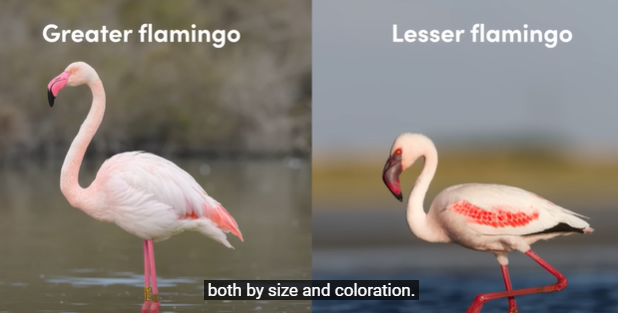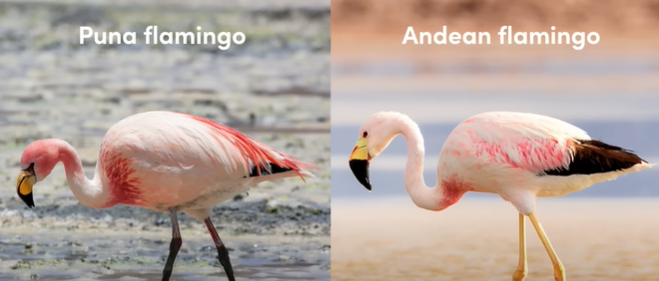Flamingos are known for their striking pink plumage, long legs, and graceful necks. These iconic birds are found across different parts of the world, and there are six distinct species, each with its own unique characteristics, habitat preferences, and behaviors. This expert overview will provide insights into all six species of flamingos, highlighting their key features and differences.
1. Lesser Flamingo (Phoenicopterus minor)
- Distribution: Lesser Flamingos are native to Africa, primarily in East African Rift Valley lakes such as Lake Nakuru and Lake Bogoria, as well as some parts of India.
- Size: They are the smallest of all flamingo species, standing around 80-90 cm (31-35 inches) tall.
- Plumage: Lesser Flamingos have a deep pink to magenta color, which is especially vibrant on their wings and neck. Their color comes from their diet, rich in algae like Spirulina.
- Diet: Primarily feed on Spirulina algae, which thrives in highly alkaline lakes. They have highly specialized bills that filter microscopic algae from the water.
- Habitat: Found in shallow, highly alkaline lakes. These conditions support the growth of algae that the Lesser Flamingo feeds on.
- Population: Estimated to be between 2-4 million individuals, making it the most populous flamingo species. However, their populations are sensitive to environmental changes.
- Conservation Status: Near Threatened, primarily due to habitat loss and changes in water levels.

2. Greater Flamingo (Phoenicopterus roseus)
- Distribution: The most widespread species, Greater Flamingos are found in parts of Africa, Southern Europe, the Middle East, and the Indian subcontinent.
- Size: Largest flamingo species, standing 120-150 cm (47-59 inches) tall.
- Plumage: Their plumage is pale pink or white with pinkish highlights on the wings. The bill is pink with a black tip.
- Diet: They have a more varied diet than Lesser Flamingos, feeding on a mix of algae, crustaceans, plankton, small fish, and mollusks. Their bills are less specialized, allowing them to filter a wider range of food.
- Habitat: Can thrive in both saline and brackish wetlands, making them adaptable to a wide range of environments.
- Population: Greater Flamingos are widespread and locally abundant, with an estimated global population of 550,000 to 680,000 individuals.
- Conservation Status: Least Concern, with stable populations across their range.
3. Chilean Flamingo (Phoenicopterus chilensis)
- Distribution: Native to South America, the Chilean Flamingo is found in wetlands in Argentina, Chile, Bolivia, and Peru, as well as introduced populations in Europe.
- Size: Medium-sized, standing about 110-130 cm (43-51 inches) tall.
- Plumage: Their plumage is pink with a grayish tint, and their legs are gray with pink bands. They have a large pink bill with a black tip.
- Diet: They feed on algae, plankton, and small invertebrates, filtering them from mud and shallow water with their specialized bill.
- Habitat: Found in high-altitude salt lakes, estuaries, and brackish coastal lagoons in South America.
- Population: The Chilean Flamingo population is estimated at around 300,000-400,000 individuals, although they face threats from habitat loss and egg collection.
- Conservation Status: Near Threatened, due to habitat destruction, especially the draining of wetlands for agriculture and mining.
4. James’s Flamingo (Phoenicoparrus jamesi)
- Distribution: James’s Flamingo is found in the high-altitude saline lakes of the Andes in Peru, Chile, Bolivia, and Argentina.
- Size: Smaller than other flamingos, standing about 90-100 cm (35-39 inches) tall.
- Plumage: Pale pink with bright red streaks on their wings and yellow legs. Their bill is yellow with a black tip, making it distinctive.
- Diet: Like the Lesser Flamingo, James’s Flamingo has a specialized diet of microscopic algae and diatoms, which it filters from the water using its specialized bill.
- Habitat: Prefers the high-altitude salt flats and lakes of the Andes, particularly those that are saline and alkaline.
- Population: Population estimates range between 100,000-150,000 individuals, and they often migrate seasonally within the Andes to find optimal feeding conditions.
- Conservation Status: Near Threatened, with populations affected by habitat degradation, water extraction, and mining activities in the Andes.
5. Andean Flamingo (Phoenicoparrus andinus)
- Distribution: Also found in the Andes, the Andean Flamingo shares much of its range with James’s Flamingo, inhabiting the high-altitude salt lakes of Peru, Chile, Bolivia, and Argentina.
- Size: Larger than James’s Flamingo, standing about 100-140 cm (39-55 inches) tall.
- Plumage: Pale pink with bright yellow legs, and their bill is yellow with a black tip, similar to James’s Flamingo but larger. The Andean Flamingo has distinctive black flight feathers that are visible during flight.
- Diet: Feeds on algae, diatoms, and small invertebrates. Their bill is specially adapted for filter-feeding in saline waters.
- Habitat: Like James’s Flamingo, Andean Flamingos inhabit high-altitude salt lakes and wetlands.
- Population: The rarest of the six flamingo species, with an estimated population of only 30,000-40,000 individuals.
- Conservation Status: Vulnerable, primarily due to habitat destruction, mining, and water diversion in their breeding and feeding areas.

6. American Flamingo (Phoenicopterus ruber)
- Distribution: Also known as the Caribbean Flamingo, this species is found in the Caribbean, the Galápagos Islands, and along the northern coast of South America.
- Size: Medium to large size, standing 120-145 cm (47-57 inches) tall.
- Plumage: Known for their vivid pink coloration, which is more intense than that of the Greater Flamingo. The bill is pink with a black tip, and the legs are entirely pink.
- Diet: Like other flamingos, the American Flamingo feeds on algae, crustaceans, and small aquatic invertebrates. Their pink coloration is the result of carotenoids in their diet.
- Habitat: Prefers shallow coastal lagoons, mudflats, and salt marshes in tropical and subtropical regions. These wetlands provide rich feeding grounds.
- Population: Estimated at 850,000-900,000 individuals, they are the most brightly colored and among the most iconic flamingos.
- Conservation Status: Least Concern, with stable populations throughout their range. However, local threats include habitat loss due to coastal development.
Summary Table: Key Differences
| Feature | Lesser Flamingo | Greater Flamingo | Chilean Flamingo | James’s Flamingo | Andean Flamingo | American Flamingo |
|---|---|---|---|---|---|---|
| Size (cm) | 80-90 | 120-150 | 110-130 | 90-100 | 100-140 | 120-145 |
| Plumage | Deep pink/magenta | Pale pink | Pink-gray | Pale pink with red streaks | Pale pink, black flight feathers | Vivid pink |
| Bill | Dark red, black tip | Pink, black tip | Pink, black tip | Yellow, black tip | Yellow, black tip | Pink, black tip |
| Habitat | Alkaline lakes (Africa, India) | Saline and brackish wetlands (Africa, Europe, Asia) | Wetlands (South America) | High-altitude salt lakes (Andes) | High-altitude salt lakes (Andes) | Coastal lagoons, salt flats (Caribbean, Americas) |
| Diet | Algae (Spirulina) | Algae, crustaceans, fish | Algae, invertebrates | Algae, diatoms | Algae, invertebrates | Algae, crustaceans |
| Population | 2-4 million | 550,000-680,000 | 300,000-400,000 | 100,000-150,000 | 30,000-40,000 | 850,000-900,000 |
| Conservation Status | Near Threatened | Least Concern | Near Threatened | Near Threatened | Vulnerable | Least Concern |
Conclusion
Flamingos, while often seen as similar in appearance, have significant differences in terms of size, habitat, diet, and population. From the vivid pink Lesser Flamingo of Africa to the rare Andean Flamingo of South America, each species occupies a unique ecological niche. Understanding these distinctions can enhance your appreciation of these beautiful birds, whether you are viewing them in the wild or learning about their conservation.
